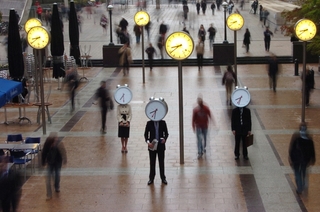And now, wearable technology. Call it wearware
Published:
28 March 2001 y., Wednesday
IBM in the jewelry business? Dutch electronics maker Philips selling street wear jackets? American high-tech start-ups creating space-age shades? Yes, yes and yes.
AT THIS YEAR’S CeBIT, IBM is showing studies of wearable computer add-ons such as a silver necklace with a hidden microphone, a lady’s display watch, earrings with speakers, and a ring whose elegant turquoise stone doubles as a nifty scroll-point mouse. Last year, Philips got together with jeans maker Levi Strauss for a limited edition of “wearable electronics garments” — jackets with a GSM mobile and an MP3 player in special pockets, with a small remote control on the front flap of the jacket and a microphone in the collar. The two devices work together, with the music turning itself off when you talk on the phone. (Available only in Europe, all 800 jackets quickly sold out). And about half a dozen companies are working on special glasses that use sophisticated optics to create screen-size images in front of your eyes.
One of the more intriguing developments in the industry is the push by some of the biggest companies into what’s become known as “wearables” — computers and accessories we can use on the go, while we’re busy doing other things. Wearables are already widespread in industry, where workers often need access to information but also need to keep their hands free. Workers building aircraft use head-mounted displays and speech-input devices for complex assembly tasks, which frees them from referring to lengthy manuals.
British Airways in experimenting with a crew of roaming check-in attendants at Heathrow’s Terminal 4, outfitted with keyboards on their forearms and a mini-display on a headset. Bell Canada sends its service technicians out to fix phone lines wearing a small computer in their pocket, a keyboard or touch-screen strapped to their wrist, and a helmet equipped with an optical display and a digital camera that beams pictures of trouble spots back to the maintenance center, wirelessly. Having quick access to precise instructions while they’re up on some telephone pole lets workers do more work in less time, says Daniel Butler, an executive at Fairfax, Virginia-based Xybernaut, maker of the wearable system BA and Bell Canada use.
Šaltinis:
NEWSWEEK
Copying, publishing, announcing any information from the News.lt portal without written permission of News.lt editorial office is prohibited.
The most popular articles
 'European workers should be limited to a 48 hour week', this was the view of the majority of MEPs at the Employment and Social Affairs Committee held Wednesday 5 November.
more »
'European workers should be limited to a 48 hour week', this was the view of the majority of MEPs at the Employment and Social Affairs Committee held Wednesday 5 November.
more »
 The World Health Organisation estimates smoking kills about 4 million people a year.
more »
The World Health Organisation estimates smoking kills about 4 million people a year.
more »
 "Hopelessness, frustration and anger” are how a senior UN official described the feelings of Palestinians in Gaza and the West Bank. Karen Koning AbuZayd spoke to us on 11 November after she had met MEPs on the Foreign Affairs and Development Committees.
more »
"Hopelessness, frustration and anger” are how a senior UN official described the feelings of Palestinians in Gaza and the West Bank. Karen Koning AbuZayd spoke to us on 11 November after she had met MEPs on the Foreign Affairs and Development Committees.
more »
 Ota city, nestled among strawberry fields in one of Japan's sunniest spots, is testimony to the allure of renewable energy in resource-poor Japan.
more »
Ota city, nestled among strawberry fields in one of Japan's sunniest spots, is testimony to the allure of renewable energy in resource-poor Japan.
more »
 Michelle Obama has won praise for her affordable look.
more »
Michelle Obama has won praise for her affordable look.
more »
 To mark 20 years of European youth programmes, 250 young people came to meet MEPs and set out their vision of Europe on 5 November.
more »
To mark 20 years of European youth programmes, 250 young people came to meet MEPs and set out their vision of Europe on 5 November.
more »
 1918, on the 11th hour of the 11th day of the 11th month the armistice that ended the fighting in the First World War came into effect.
more »
1918, on the 11th hour of the 11th day of the 11th month the armistice that ended the fighting in the First World War came into effect.
more »
 The violence between the Armenian and Greek Orthodox groups flared at Jerusalem's Church of the Holy Sepulchre.
more »
The violence between the Armenian and Greek Orthodox groups flared at Jerusalem's Church of the Holy Sepulchre.
more »
 Barack Obama would have won easily by a landslide if Europeans had been voting.
more »
Barack Obama would have won easily by a landslide if Europeans had been voting.
more »
 Omar Osama bin Laden stopped off in Madrid's Barajas Airport yesterday seeking political asylum.
more »
Omar Osama bin Laden stopped off in Madrid's Barajas Airport yesterday seeking political asylum.
more »